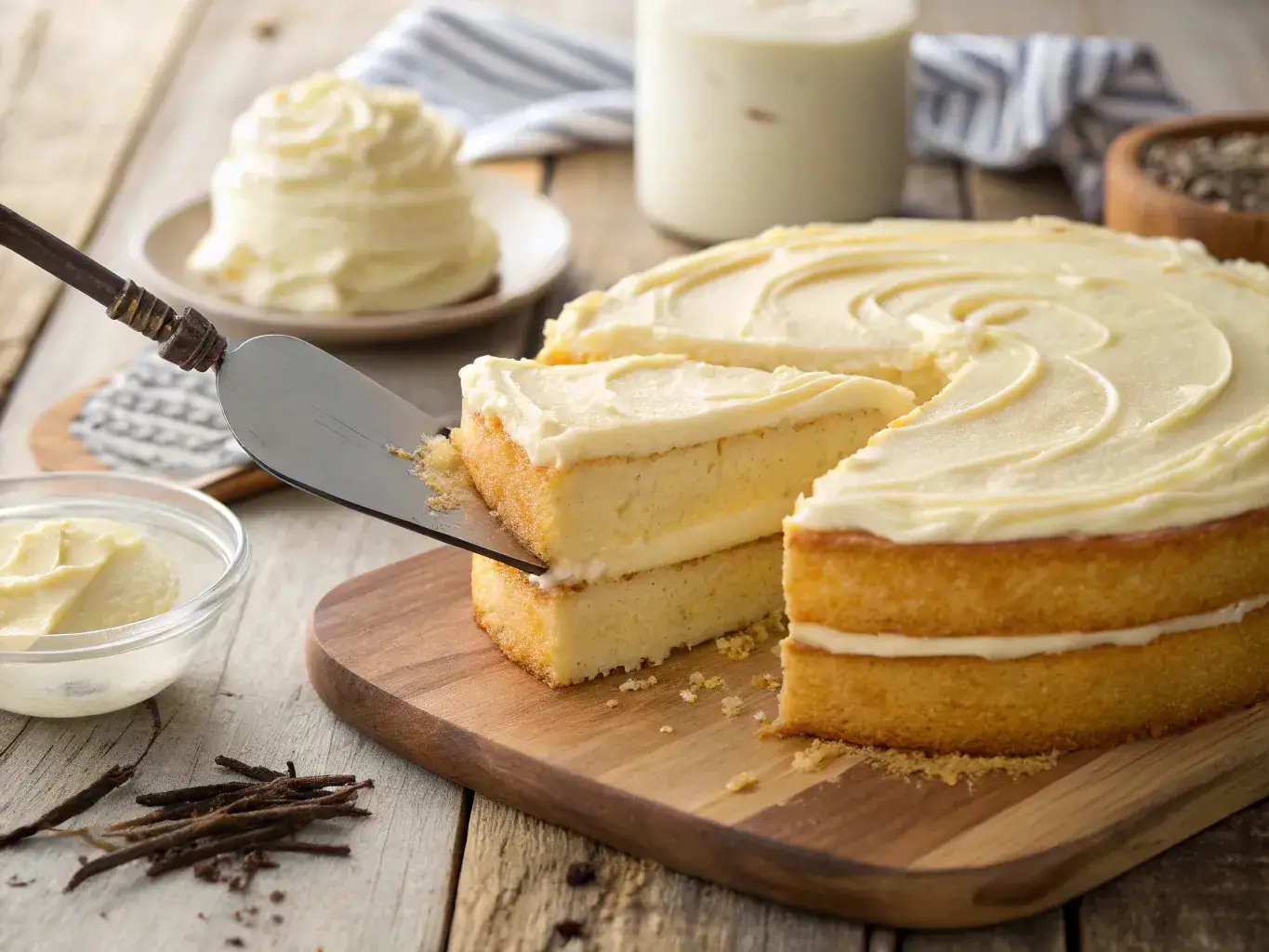Vanilla pudding frosting is the soft, luscious topping you didn’t know your cakes needed. At Recipes of Kitchen, The Gluten-Free Sweet Kitchen, I’ve discovered that gluten-free baking doesn’t mean giving up indulgent desserts—it means reimagining them. This frosting is one of those reimagined gems.
Born from my journey into gluten-free baking after discovering my gluten sensitivity, this simple recipe became a staple in my kitchen. It’s lighter than buttercream, easy to make, and adds a nostalgic, creamy texture that transforms even the simplest bake into something special.
In this article, I’ll show you how to make vanilla pudding frosting, how to thicken it, when to use it, and how it compares with traditional frostings—so your next dessert is as smooth as it is unforgettable.
Understanding Vanilla Pudding Frosting
What Is Vanilla Pudding Frosting?
Vanilla pudding frosting is a smooth, creamy frosting alternative made by combining instant vanilla pudding mix with milk, whipped cream, or even cream cheese to create a light, whipped topping for cakes and cupcakes. Unlike traditional buttercream, which relies heavily on butter and sugar, this version delivers flavor and texture with less fat and more versatility.
Its unique appeal lies in its silky texture and subtle vanilla flavor. It’s perfect for those who want a not-too-sweet option or who need a frosting that complements rather than overpowers their dessert.
Especially in gluten-free baking, where textures and consistencies can vary wildly, vanilla pudding frosting provides a stable, rich alternative that adapts well to non-traditional flours and delicate crumb structures.
Print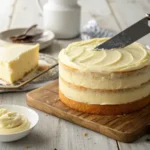
Vanilla Pudding Frosting: The Creamy Secret Bakers Love
- Total Time: 10 minutes
- Yield: 2 cups 1x
- Diet: Vegetarian
Description
A light, fluffy, and creamy frosting made with instant vanilla pudding — perfect for cakes, cupcakes, or even as a dip.
Ingredients
1 (3.4 oz) box instant vanilla pudding mix
1 cup cold milk
1/2 cup unsalted butter, softened
1/2 cup powdered sugar
1 tsp vanilla extract
1 cup heavy whipping cream
Instructions
1. In a large mixing bowl, combine the instant vanilla pudding mix and cold milk. Whisk until it begins to thicken, about 2 minutes.
2. Add the softened butter, powdered sugar, and vanilla extract. Beat with an electric mixer until smooth and fluffy.
3. In a separate bowl, whip the heavy cream until stiff peaks form.
4. Fold the whipped cream into the pudding mixture gently until fully incorporated.
5. Chill the frosting for at least 15–20 minutes before spreading or piping.
Notes
This frosting holds its shape well and pipes beautifully.
Keep refrigerated if not using immediately.
You can adjust the sweetness by adding more or less powdered sugar.
Try using other pudding flavors like chocolate or cheesecake for variety.
- Prep Time: 10 minutes
- Cook Time: 0 minutes
- Category: Frosting
- Method: No-Bake
- Cuisine: American
Nutrition
- Serving Size: 2 tablespoons
- Calories: 90
- Sugar: 7g
- Sodium: 70mg
- Fat: 6g
- Saturated Fat: 4g
- Unsaturated Fat: 1.5g
- Trans Fat: 0g
- Carbohydrates: 8g
- Fiber: 0g
- Protein: 1g
- Cholesterol: 20mg
Keywords: vanilla pudding frosting, whipped frosting, easy frosting, no bake
Difference Between Pudding and Traditional Frosting
While both pudding and traditional frosting aim to elevate a dessert, their ingredients, texture, and usage are quite different:
| Feature | Vanilla Pudding Frosting | Traditional Frosting (e.g., Buttercream) |
|---|---|---|
| Base | Instant pudding mix or homemade pudding | Butter + powdered sugar |
| Texture | Light, creamy, mousse-like | Dense, rich, can be heavy |
| Sweetness | Mild and subtle | Often intensely sweet |
| Customization | Easily mixed with whipped cream or flavor infusions | Limited due to high fat content |
| Stability | Requires chilling to hold shape | Stable at room temp |
| Ideal For | Gluten-free cakes, light bakes, summer desserts | Layer cakes, piping, high-decor bakes |
If you’re baking for those with food sensitivities, or you’re simply looking for a frosting that won’t weigh down your dessert, this pudding-based frosting is a game changer.
Can You Use Vanilla Pudding as Frosting?
Answering: “Can You Use Vanilla Pudding as Frosting?”
Yes, you absolutely can use vanilla pudding as frosting—with a few smart adjustments. On its own, vanilla pudding is smooth and creamy, but too thin to hold shape or cling properly to baked goods. However, when blended with ingredients like whipped topping, cream cheese, or butter, it transforms into a light, fluffy, and stable frosting that’s perfect for cakes, cupcakes, and even cookies.
Using vanilla pudding frosting is a fantastic alternative for those who find traditional buttercream too rich or overly sweet. It’s a favorite in my gluten-free kitchen, especially when I want something that’s crowd-pleasing, easy to make, and gentle on the stomach.
Here’s why it works:
- Flavor-forward: The pudding adds real vanilla flavor, not just sugar.
- Flexible texture: You can control the consistency—fluffy for piping or soft for spreading.
- Kid-approved: Not overly sweet, making it ideal for birthday cakes and school treats.
When It Works and When It Doesn’t
There’s a time and place for vanilla pudding frosting. It works beautifully for:
- Sheet cakes and layer cakes where a light, creamy topping is preferred.
- Cupcakes that need a soft swirl.
- Chilled desserts, like trifles or poke cakes.
However, it may not be the best choice when:
- You’re decorating with intricate piping that requires structure.
- The dessert will sit outdoors or in heat—pudding-based frostings need to stay cool.
- You want a very firm or crust-setting finish, like with royal icing or stiff buttercream.
To make it more reliable, I often blend in whipped cream or a touch of gelatin to help the structure hold—especially for summer events or tall cakes.
Looking for inspiration? Try our Dark Chocolate Granola as a crunchy topping on pudding-frosted cupcakes!
How to Make Vanilla Pudding Frosting
Basic Ingredients You’ll Need
To whip up a smooth and creamy vanilla pudding frosting, you only need a few pantry staples. Most of these ingredients are naturally gluten-free, but always check labels to ensure no hidden additives sneak in.
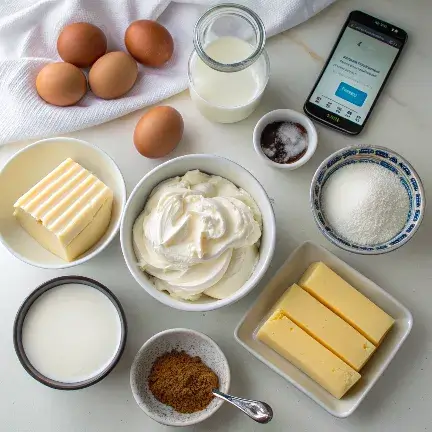
Here’s what you’ll need:
| Ingredient | Purpose | Notes |
|---|---|---|
| Instant vanilla pudding mix | Base for the frosting | Use gluten-free certified brand |
| Cold milk | Activates pudding and adds creaminess | Whole milk preferred for richness |
| Whipped topping (or whipped cream) | Adds volume and lightness | Can use dairy-free coconut whip if needed |
| Powdered sugar (optional) | Adjusts sweetness | Only needed if you want it sweeter |
| Butter or cream cheese (optional) | Adds stability and richness | Use for thicker texture or extra flavor |
| Vanilla extract | Boosts flavor | Pure extract is best |
These ingredients combine to create a smooth, pipe-able frosting that’s easier on the sugar but still full of flavor.
Step-by-Step Recipe for Creamy Vanilla Pudding Frosting
This recipe yields enough frosting for a 9×13 sheet cake or 18–24 cupcakes.
Classic Vanilla Pudding Frosting
Ingredients:
- 1 package (3.4 oz) gluten-free instant vanilla pudding mix
- 1 cup cold whole milk
- 1 ½ cups whipped topping or freshly whipped cream
- 1 tsp pure vanilla extract
- (Optional) ¼ cup softened butter or cream cheese for richness
- (Optional) ¼ cup powdered sugar to taste
Instructions:
- Whisk the pudding mix and milk together in a medium bowl for about 2–3 minutes until thickened.
- Let the pudding sit in the refrigerator for 5 minutes to firm up.
- Fold in the whipped topping gently until fully combined and fluffy.
- Add vanilla extract and mix in optional butter or powdered sugar if desired.
- Use immediately or chill until ready to frost.
Tips for Best Results:
- Don’t overmix after adding the whipped cream—it may deflate.
- For firmer frosting, blend in ¼ tsp of unflavored gelatin (bloomed in water).
- Store in the fridge for up to 3 days.
This method delivers a frosting that’s cloud-light, perfectly vanilla-flavored, and totally kid- and gluten-free friendly.
Looking for a creative use? Don’t miss our Dark Chocolate Granola—use it as a crunchy topping over pudding-frosted cupcakes.
How to Thicken Pudding for Frosting Use
Answering: “How Do You Thicken Pudding for Frosting?”
If your vanilla pudding frosting turns out too runny or loose to spread, don’t worry—it’s fixable. Thickening pudding for frosting is all about using the right methods and ratios. Whether you’re using instant pudding or a homemade version, it needs structure to hold up on baked goods.
Here are the most effective techniques:
- Reduce liquid: Use slightly less milk than the package calls for. For example, instead of 2 cups, try 1 ¼ to 1 ½ cups.
- Chill it longer: Refrigerating the pudding for 30 minutes or more helps it set fully before mixing with whipped topping.
- Add stabilizers: Use cornstarch, gelatin, or cream cheese to create more body.
Thick pudding means better hold and a more frosting-like finish that stays firm on cupcakes or cakes.
Thickening Techniques: Cornstarch, Whipped Cream, Gelatin & More
Here’s a quick guide to common thickeners:
| Thickening Agent | How to Use | Effect on Texture |
|---|---|---|
| Cornstarch | 1–2 tbsp dissolved in cold milk, heat briefly | Thickens without adding fat |
| Gelatin | ½ tsp bloomed in water, added to warm pudding | Firm structure for warm weather |
| Cream Cheese | ¼–½ cup beaten into pudding | Adds body and tangy flavor |
| Butter | 2–4 tbsp softened, whipped in | Richer, firmer, slightly heavier |
| Whipped Cream | Folded in gently, then chilled | Fluffier, holds shape when cool |
Each has its benefits depending on the consistency and flavor you’re going for. For a light and fluffy vanilla pudding frosting, I love combining whipped cream with a touch of cream cheese for the perfect balance of stability and softness.
What Professional Bakers Use for Frosting
Answering: “What Do Professional Bakers Use for Frosting?”
Professional bakers usually stick with reliable classics like Swiss meringue buttercream, American buttercream, and cream cheese frosting. These types offer structure, can be piped, colored, and stored well—even at room temperature.
However, there’s a growing trend toward lighter alternatives, especially for gluten-free or health-conscious bakeries. That’s where vanilla pudding frosting comes in as a modern, allergen-friendly choice that doesn’t compromise on flavor or presentation.
Here’s what bakers love about traditional options:
- American Buttercream: Sweet, dense, easy to color
- Swiss Meringue: Silky, less sweet, smooth finish
- Whipped Ganache: Rich, chocolatey, sophisticated
- Cream Cheese Frosting: Tangy and moist, ideal for red velvet or carrot cake
And here’s why some are turning to pudding frosting:
- Lower sugar content
- Quick to prepare
- Better for refrigerated desserts
- Kid- and allergy-friendly
Buttercream vs. Vanilla Pudding Frosting: A Quick Comparison
| Feature | Buttercream | Vanilla Pudding Frosting |
|---|---|---|
| Flavor | Very sweet, buttery | Subtle, creamy vanilla |
| Texture | Dense, can crust | Light, airy, mousse-like |
| Skill level needed | Medium (requires whipping) | Easy (mix and chill) |
| Best for | Layer cakes, piping | Cupcakes, poke cakes, sheet cakes |
| Storage | Room temp or chilled | Must be refrigerated |
So while professionals often opt for buttercream or meringue, they’re not ignoring the charm of a well-made vanilla pudding frosting—especially in modern gluten-free or low-sugar bakeries.
Best Frosting for Vanilla Cake
Answering: “What Is the Best Frosting for a Vanilla Cake?”
The best frosting for a vanilla cake depends on your goal—do you want richness, elegance, or lightness? Traditional buttercream is often the default, but more and more bakers are turning to vanilla pudding frosting for its smooth, fluffy texture and subtle sweetness that enhances rather than overpowers the cake.
Here’s how it compares:
- Buttercream: Bold and buttery, but heavy and sugary.
- Cream Cheese Frosting: Tangy, rich, best for layered or spice-based cakes.
- Whipped Frosting: Light, airy, but not always stable.
- Vanilla Pudding Frosting: Perfectly balanced—light, easy to spread, chilled for freshness, and gluten-free adaptable.
If you’re baking a gluten-free vanilla cake, like many featured at Recipes of Kitchen, this frosting is the ideal complement. It won’t crush the delicate crumb, and its moisture helps bind gluten-free textures naturally.
Would you be able to give me a cake that pairs beautifully? Don’t miss our Banana and Almond Meal Cake—a soft, flavorful base that complements vanilla pudding frosting with every bite.
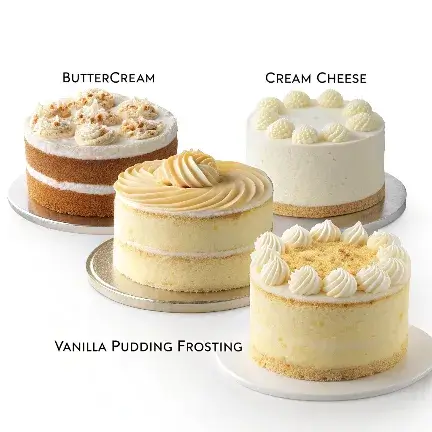
How Vanilla Pudding Frosting Compares with Others
Here’s a comparison table to help you choose the best frosting for your vanilla cake:
| Frosting Type | Flavor Profile | Texture | Best For |
|---|---|---|---|
| American Buttercream | Very sweet, rich | Dense, pipable | Birthday cakes, high design |
| Swiss Meringue Buttercream | Mild, elegant | Silky, stable | Wedding cakes, smooth finishes |
| Cream Cheese Frosting | Tangy, rich | Soft, spreadable | Carrot, red velvet, spice cakes |
| Vanilla Pudding Frosting | Light, creamy vanilla | Whipped, airy | Vanilla cakes, poke cakes, cupcakes |
If you prefer a light, not-too-sweet frosting that lets the vanilla cake shine, vanilla pudding frosting is your go-to.
Creative Variations of Vanilla Pudding Frosting
Adding Cocoa, Cream Cheese, or Fruit Infusions
One of the best things about vanilla pudding frosting is how versatile it is. You can create multiple flavor profiles by blending in just a few extra ingredients.
Here are some popular variations:
- Chocolate Pudding Frosting: Add 2 tbsp cocoa powder to the vanilla pudding base for a light chocolate twist.
- Strawberry Vanilla Frosting: Puree ¼ cup of strawberries and fold them in for fruity freshness.
- Cream Cheese Blend: Add ½ cup whipped cream cheese for tang and richness—great for red velvet or pumpkin cupcakes.
- Coconut Pudding Frosting: Swap milk for coconut milk and top with shredded coconut.
This adaptability is especially helpful for gluten-free baking. Since the base is already light and non-crumbly, it allows creative combinations without destabilizing your final dessert.
Looking for inspiration? Try topping our Eggless Banana Chocolate Chip Muffins with strawberry vanilla pudding frosting—it’s a match made in dessert heaven.
Dairy-Free and Vegan Vanilla Pudding Frosting Options
If you’re baking for dietary restrictions, don’t worry—vanilla pudding frosting can be completely dairy-free and still delicious.
Here’s how to make it vegan:
- Use plant-based milk: Almond, oat, or coconut milk work well.
- Choose vegan instant pudding: Look for brands free of dairy and gluten.
- Swap whipped topping: Use coconut whipped cream or cashew cream.
- Avoid gelatin: Use agar-agar if you need structure.
Vegan vanilla pudding frosting is soft, cool, and smooth—perfect for summer treats or anyone avoiding dairy. You won’t even miss the traditional version!
Would you be interested in a finishing touch? How do I make a Vanilla Pudding Cream Cheese and Cool Whip dessert? makes a fantastic crunchy topping for these vegan-friendly creations.
Tips to Use and Store Vanilla Pudding Frosting
How to Frost and Store Cakes with Pudding-Based Frosting
Frosting with vanilla pudding frosting is slightly different than using heavy buttercream, but the result is a beautifully smooth, light texture that spreads like a dream. Because it’s softer, here’s how to get the best results:
Frosting Tips:
- Chill the frosting for 15–30 minutes before applying—it thickens up just enough to hold better.
- Use an offset spatula for even spreading on cakes or cupcakes.
- Apply a crumb coat if using it for layered cakes; let it chill, then add the final layer.
- Avoid hot environments—this frosting doesn’t like heat or direct sunlight.
Storage Tips:
- Refrigeration is a must. Vanilla pudding frosting is dairy-based and should always be stored cold.
- Cover your frosted dessert with plastic wrap or a cake dome and store it in the fridge for up to 3 days.
- If you made extra, keep leftover frosting in an airtight container for up to 5 days.
- Always stir lightly before reusing to refresh the texture.
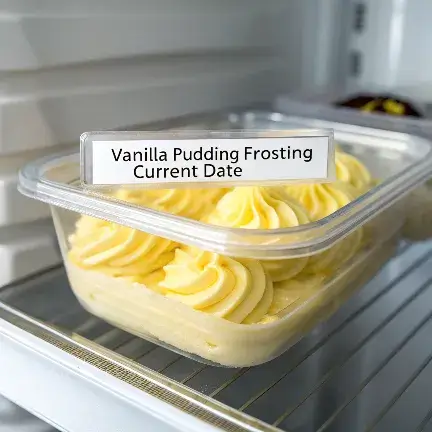
This frosting is ideal for refrigerated desserts like poke cakes, trifles, or cupcakes served chilled.
Looking for more cool dessert ideas? Check out our Earl Grey Panna Cotta for a silky, tea-infused treat that’s perfect served cold.
How Long It Lasts and Freezing Tips
While vanilla pudding frosting is fridge-friendly, freezing it can be tricky. The pudding base doesn’t always thaw with a smooth texture, but it can work with a few precautions:
Freezing Guidelines:
- Only freeze for up to 2 weeks, in an airtight container.
- Thaw slowly in the fridge overnight—never at room temp.
- After thawing, re-whip or fold in a bit of fresh whipped cream to restore fluffiness.
If you’re planning ahead, it’s better to prep the pudding base and freeze that—then fold in whipped cream fresh before using.
Mistakes to Avoid When Making Vanilla Pudding Frosting
Common Issues: Runny, Lumpy, or Too Soft
Even though vanilla pudding frosting is simple to make, it’s still possible to run into a few hiccups. Don’t worry—most problems are easy to fix with a little know-how.
Here are some of the most common mistakes and how to avoid them:
| Problem | Why It Happens | How to Fix It |
|---|---|---|
| Runny texture | Too much milk, not enough thickener | Use less milk or add cornstarch/cream cheese |
| Lumpy appearance | Powder not fully dissolved or mixed too fast | Whisk slowly and let pudding sit before folding |
| Too soft to hold shape | Warm ingredients or overmixing | Chill ingredients and avoid over-stirring |
| Separating layers | Pudding and cream not blended well | Fold gently and refrigerate immediately |
Troubleshooting and Fixes
Tip #1: Always use cold milk when making pudding—warm milk can break down instant mix.
Tip #2: Let the pudding fully set (5–10 minutes in the fridge) before adding anything to it.
Tip #3: If it’s too soft, add more whipped topping one spoonful at a time or mix in 1–2 tbsp of softened butter.
Tip #4: If the pudding isn’t setting, switch to a stabilized whipped cream for better results.
Every baker makes mistakes—even pros. But with this guide, your vanilla pudding frosting will come out perfect every time.
FAQs About Vanilla Pudding Frosting
Can you use vanilla pudding as frosting?
Yes, you can use vanilla pudding as frosting with a few simple tweaks. On its own, pudding is too soft to hold shape, but when combined with whipped topping, cream cheese, or butter, it turns into a creamy, fluffy frosting. It’s perfect for cupcakes, cakes, poke cakes, and other chilled desserts.
How do you thicken pudding for frosting?
To thicken pudding for frosting, use less milk than the box directions suggest. You can also add cornstarch, cream cheese, or stabilized whipped cream. Chill the pudding before combining it with other ingredients, and let it rest in the refrigerator after mixing to firm up before frosting.
What do professional bakers use for frosting?
Professional bakers often use buttercream (American or Swiss meringue), ganache, or cream cheese frosting for structure and stability. However, many modern bakers—especially in health-conscious or allergen-friendly kitchens—use vanilla pudding frosting for lighter, chilled desserts.
What is the best frosting for a vanilla cake?
The best frosting for a vanilla cake depends on your preference. If you want something light, creamy, and less sweet, vanilla pudding frosting is ideal. It enhances the flavor of vanilla cake without overpowering it, and it’s great for gluten-free or summer desserts that benefit from a cooler topping.
Conclusion: Why Vanilla Pudding Frosting Deserves a Spot in Your Recipe Box
Vanilla pudding frosting might not be the most traditional choice—but once you try it, you’ll wonder why you didn’t use it sooner. It’s smooth, light, versatile, and surprisingly easy to make, even for beginner bakers. From gluten-free cakes to allergy-friendly cupcakes, this frosting is the perfect fit when you want something creamy without the sugar overload.
Whether you need a quick dessert topping, a kid-approved cake layer, or a dairy-free option, vanilla pudding frosting gives you all the flexibility of a classic with none of the heaviness.
Now that you know how to master vanilla pudding frosting, it’s time to bring it to life in your kitchen.

